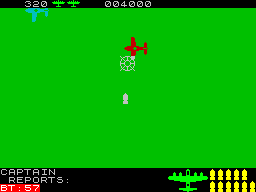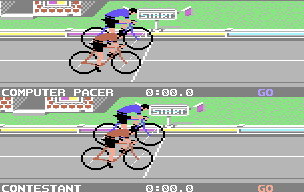Digital Integration's succinctly-named Fighter Pilot is without a doubt the most fully-featured combat flight sim I've covered as of yet. Not since SubLogic's Flight Simulator have I seen one that features takeoff, landing, plausible flying mechanics, air-to-air combat, and seamless transition between them all. And that game's combat was an afterthought, and everything else besides so rough that it makes Fighter Pilot look like Falcon 4.0.
 |
| Flight Simulator. This is a dogfight! |
 |
| Fighter Pilot loses FS1's scenery, but at least you can read the damn instruments. |
You definitely want to use a joystick to play - the keyboard yoke controls are clumsily mapped to the 5,6,7,8 number row cluster. Either way, you will need to learn to cope with some awkward input polling - light taps do nothing, but long presses send you spinning wildly. Given the frequent need to make precise adjustments for minor course correction or to level out, you'll need to get comfortable with the exacting timing that you need to push the stick just long enough to register as input, and no longer.
The manual is restricted to six pages of cassette liner notes, which are well written and use their space economically, but sparse on actual flying technique, particularly when it comes to landing. It took a good deal of trial and error to work out viable techniques on my own, and in the end I didn't quite feel like I was doing things right
Fighter Pilot offers four scenarios:
- Landing practice - Start airborne, and land on the runway.
- Flying training - Start on a runway, takeoff, and land.
- Air-to-air combat practice - Start airborne and engage a drone.
- Air-to-air combat - The complete package. Start on a runway, takeoff, engage hostiles, and land before fuel runs out.
There are four difficulty settings, which as far as I can tell only effect air-to-air combat by increasing the enemies' shooting accuracy, but does not affect their flight skill. There are also two independent difficulty-increasing options; blind landing, which encases the ground in fog and forces you to approach and land guided with instruments alone, and cross-winds, which affect your speed and lateral drift. No thank you!
I did complete each scenario in order, as the first three scenarios are practice for the fourth - landing is definitely something you want to get a good handle on before trying a combat mission.
Landing practice
Begin five miles from a runway, already oriented for a center-line landing, at 1700 feet. As long as crosswinds are not enabled, you will not need to perform any course correction, and this is not too difficult once you have a good glide-slope technique. If you do have crosswinds then I have no idea how you can possibly manage to compensate with these controls that manage to be too sensitive and not sensitive enough at the same time.
My technique is to immediately lower the flaps, which dramatically reduces speed and increases lift, then raise thrust to just below 7.5 notches, and raise the nose until VSI shows a descent of about 12 ft/s - you might not be able to hit this exactly. ILS is important but limited in usefulness - it seems to be calibrated to a fixed glidepath and won't be much help if you deviate too much from it. But it will help with making small corrections. Leave thrust alone and gently adjust pitch to correct your glidepath as needed, using 12 ft/s as the baseline descent rate. Once you get close, VSI becomes useless and you'll need to trust your own eyes.
On touchdown, kill thrust and slam the brakes. You shouldn't be landing at more than 135kn, and the F-15 can come to a stop from that pretty quickly.
The manual gives some terse notes on how to perform a flaps-up landing (these can be damaged in flight!), but either I'm missing something or the method given just doesn't work. The printed thrust and nose angle causes the Eagle to cruise at 200kn with zero altitude loss, missing the runway completely. Decreasing the thrust even a little bit causes rapid loss of speed and altitude until it stalls and crashes. Decreasing pitch makes it rapidly build speed until it gets fast enough to rip off the landing gear. Still, I did manage to land flaps-up once, by retracting the undercarriage, descending to under 100ft, then approaching at cruising speed and decreasing pitch at the last moment to land, which I suspect is not a safe landing technique in real life.
This is a good first exercise, and with some practice I could land the plane consistently, but it skips the most difficult part of landing - orienting with the runway.
Flying training
In this scenario, you must take off from an airbase and land. You have a choice of four airbases to land at, though one of them is nearly impossible to.
Takeoff is easy - you are already oriented line-center on the runway and don't need to taxi, and the F-15 can take off with flaps up just fine. Just increase thrust to full, lift up at 160kn, and don't forget to retract the undercarriage.
Once airborne, you can fly around at your leisure. As long as you don't let the airspeed fall below 130kn, or do something dumb like lower the flaps or undercarriage at high speeds, you're fine. It's not real interesting though - the terrain is almost completely featureless. Even the mountains are not rendered as scenery - they are simply invisible regions marked only on the map that instantly crash you if your altitude isn't high enough.
The manual does nothing to explain runway alignment, but the beacons are key. Three of the bases are flanked by beacons which can be selected to show their bearing and distance on radar. The fourth base, Zulu, lacks beacons, and I don't see how you're supposed to land on it. I find you need a good 20-25 miles out from an airbase to be able to stick the landing; it takes time to oriented the plane correctly, and you get closer while making adjustments. Furthermore, bearings are only accurate to the degree, so as you get closer to the base, that 270° reading may well become 271° require further course adjustment.
 |
| Flying toward Delta. Note the 274° bearing to beacon 4. |
 |
| Some correction is needed! |
At 6m distance, the flight computer becomes available which can help you make your final course adjustments.
 |
| 471ft north of the runway. Gotta bear left a bit. |
Hopefully you don't need to fuss with this too much and wind up flying right over the runway while fighting the somewhat stiff and imprecise controls to align with it!
Air-to-air combat practice
This scenario starts you out in the air and close to a drone, which you'll quickly run into and be able to shoot down with your Vulcan - no lock-on missiles here!
After killing the drone, a real fighter spawns, and can be located using the radar for distance and bearing and flight computer for altitude. The map will also show you its position and heading.
Visual range is under one mile, effective weapon range is less than that, and trying to fight head-on is futile; as you'll just scream past each other in the blink of an eye. You've got to get on its tail and stay on it as it tries to shake you, and you'll need to go just fast enough to catch it, but not so much faster that you cannot match its maneuvers. Once in range and in your sights you can gun it down. Instrumentation will not tell you the speed, and is also not precise enough to be useful when it enters visual range; you'll have to rely on your eyes and intuition.
 |
| I pull off death from above. |
After kill, you can land, or you can continue to fight - regular
fighters continue to spawn. If you're good, they won't have much
of a chance to hit you, but on higher difficulties they may land a hit during the
initial split-second flyby. Damage modeling is simplistic; four hits will kill you.
Air-to-air combat
This is the total Fighter Pilot experience. Enemy fighters spawn immediately - infinitely but thankfully only one at a time - and they're coming for your airbases. Everything you've practiced in the first three scenarios is used here - take off, hunt and kill as many enemies as your fuel and fuselage integrity allows, and land.
The above video (note - the game has no sound!) demonstrates my best run at air-to-air combat, at the easiest difficulty settings, in which I kill four enemies before landing and very nearly out of fuel. I managed five in one prior run, but botched the landing.
Some luck is involved - fighters will target airbases when you are not engaging them, and you will lose some! If a fighter spawns far from you, and they will, it will almost certainly destroy the nearest airbase long before you can intercept it. Just hope that they don't leave you with the useless Zulu base. Conversely, during one attempt, fighters wouldn't stop spawning close to me (and the only viable airbase), and I ran out of fuel fighting them, unable to land.
GAB rating: Average. I'm impressed by the fullness of this simulation given the early timeframe of its release. In some ways it's more impressive than Microprose's F-15 Strike Eagle of the following year - it runs at a better framerate despite the poorer hardware, simulates takeoff and landing, and the cannon duels are more engaging than F-15's fire-and-forget missile combat, if perhaps anachronistic in the age of jet warfare.
That said, it wasn't especially enjoyable, thanks to the somewhat clumsy controls. They're workable, but just annoying enough that I felt like I was fighting them more than I was engaging with the flight and combat mechanics. Simulations like this have a short shelf life anyway. When the goal, as the liner notes say, is approximate a realistic simulation to the best ability of computing's limitations, the effort quickly becomes irrelevant as technology improves and later sims do it better.






















































